Managing Food Production: Systems, Design, and Analysis Report
VerifiedAdded on 2023/01/19
|25
|7343
|1
Report
AI Summary
This report delves into the intricacies of managing food production, encompassing various food preparation and production systems such as traditional, centralized, cook-chill, and cook-freeze methods, alongside assembly line and galley kitchen designs. It explores the factors influencing kitchen design, including budget, layout, menu, and food safety, and compares and contrasts different kitchen layouts like one-wall, L-shaped, and centralized kitchens. The report also examines key principles for planning food production and preparation, methods for monitoring food production to identify variances, and the potential effects of deviations from established processes. Furthermore, it analyzes the advantages and disadvantages of different food production systems, emphasizing the importance of food safety and efficient operations within the food industry. The report concludes with an overview of monitoring approaches and their effectiveness.
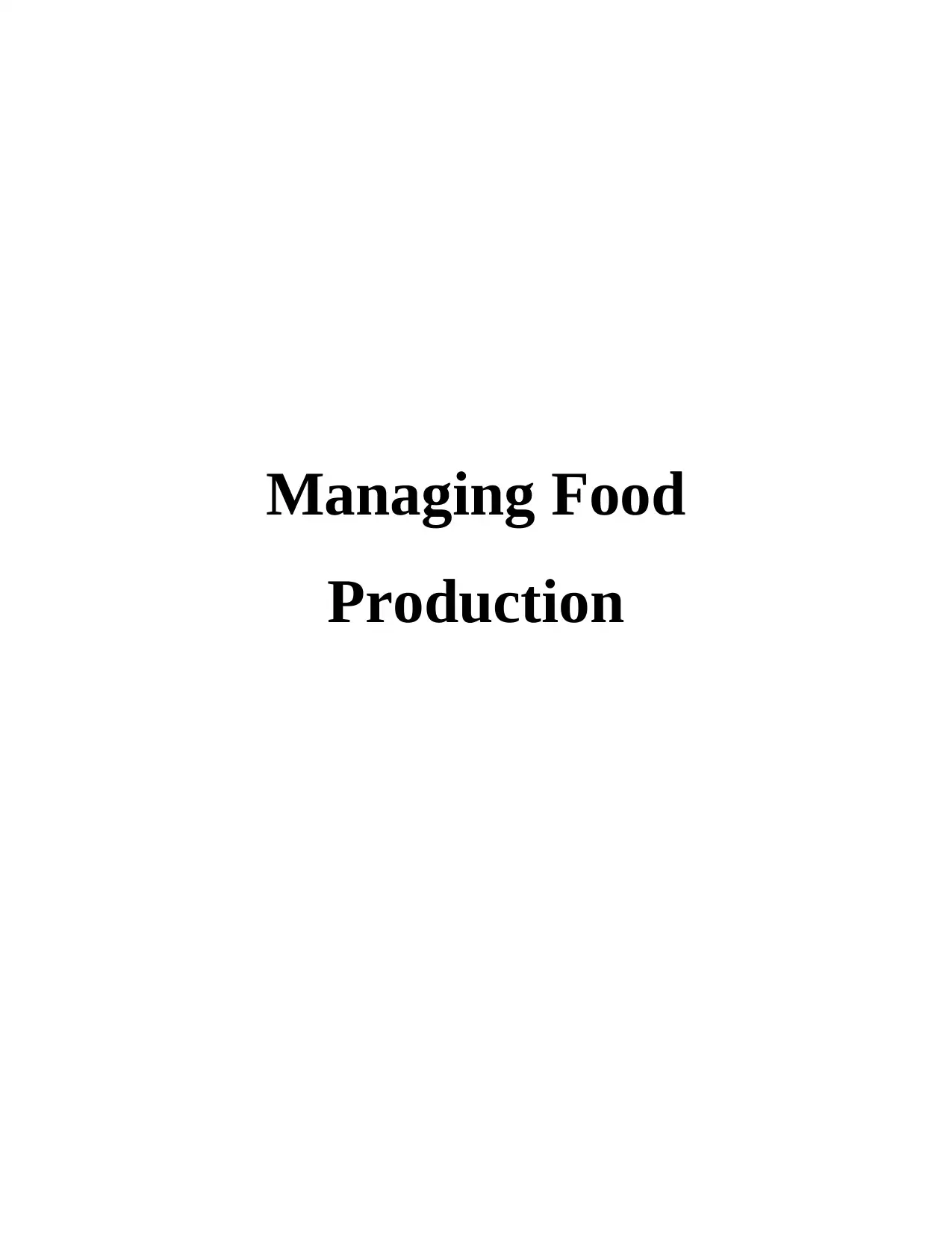
Managing Food
Production
Production
Paraphrase This Document
Need a fresh take? Get an instant paraphrase of this document with our AI Paraphraser
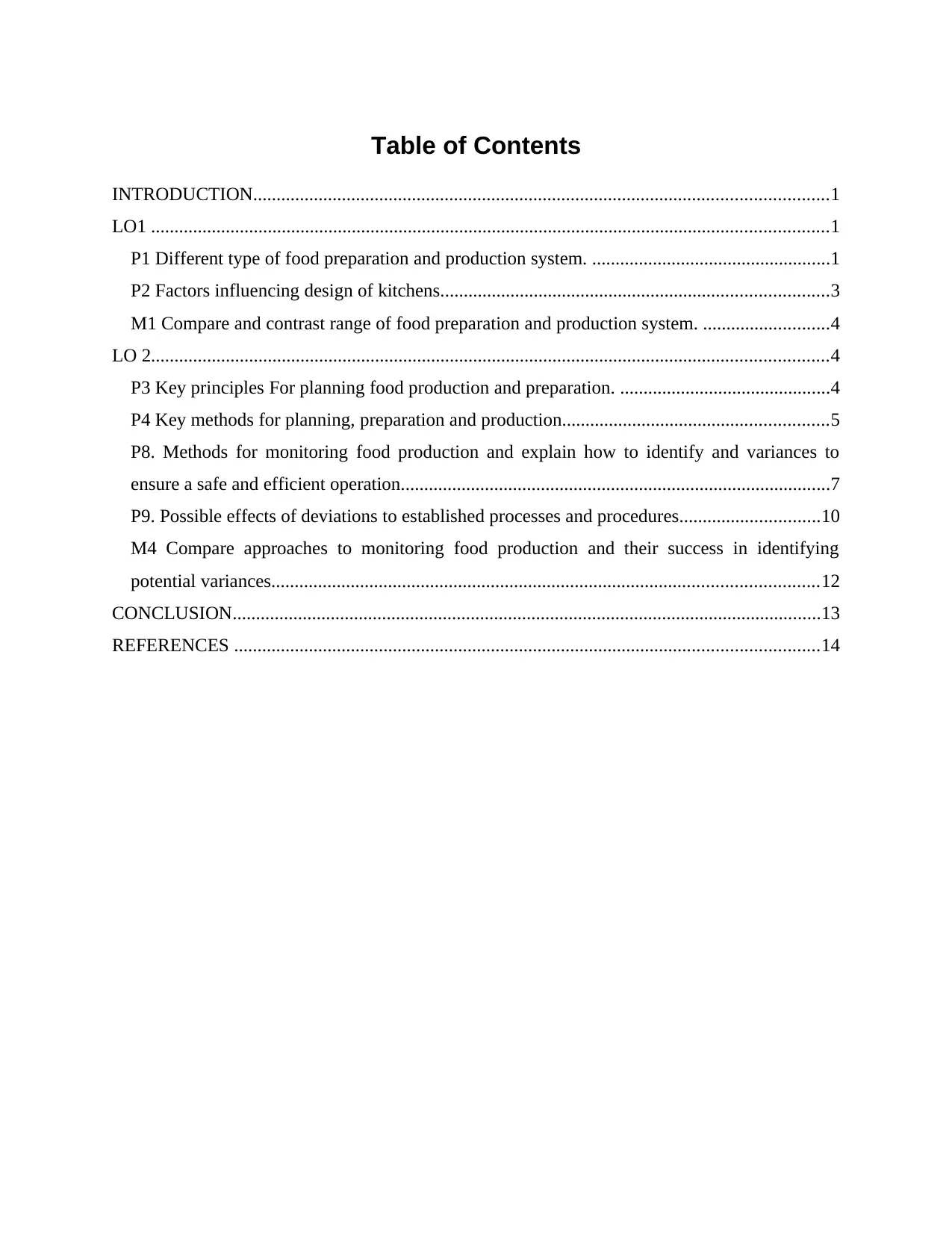
Table of Contents
INTRODUCTION...........................................................................................................................1
LO1 .................................................................................................................................................1
P1 Different type of food preparation and production system. ...................................................1
P2 Factors influencing design of kitchens...................................................................................3
M1 Compare and contrast range of food preparation and production system. ...........................4
LO 2.................................................................................................................................................4
P3 Key principles For planning food production and preparation. .............................................4
P4 Key methods for planning, preparation and production.........................................................5
P8. Methods for monitoring food production and explain how to identify and variances to
ensure a safe and efficient operation............................................................................................7
P9. Possible effects of deviations to established processes and procedures..............................10
M4 Compare approaches to monitoring food production and their success in identifying
potential variances.....................................................................................................................12
CONCLUSION..............................................................................................................................13
REFERENCES .............................................................................................................................14
INTRODUCTION...........................................................................................................................1
LO1 .................................................................................................................................................1
P1 Different type of food preparation and production system. ...................................................1
P2 Factors influencing design of kitchens...................................................................................3
M1 Compare and contrast range of food preparation and production system. ...........................4
LO 2.................................................................................................................................................4
P3 Key principles For planning food production and preparation. .............................................4
P4 Key methods for planning, preparation and production.........................................................5
P8. Methods for monitoring food production and explain how to identify and variances to
ensure a safe and efficient operation............................................................................................7
P9. Possible effects of deviations to established processes and procedures..............................10
M4 Compare approaches to monitoring food production and their success in identifying
potential variances.....................................................................................................................12
CONCLUSION..............................................................................................................................13
REFERENCES .............................................................................................................................14
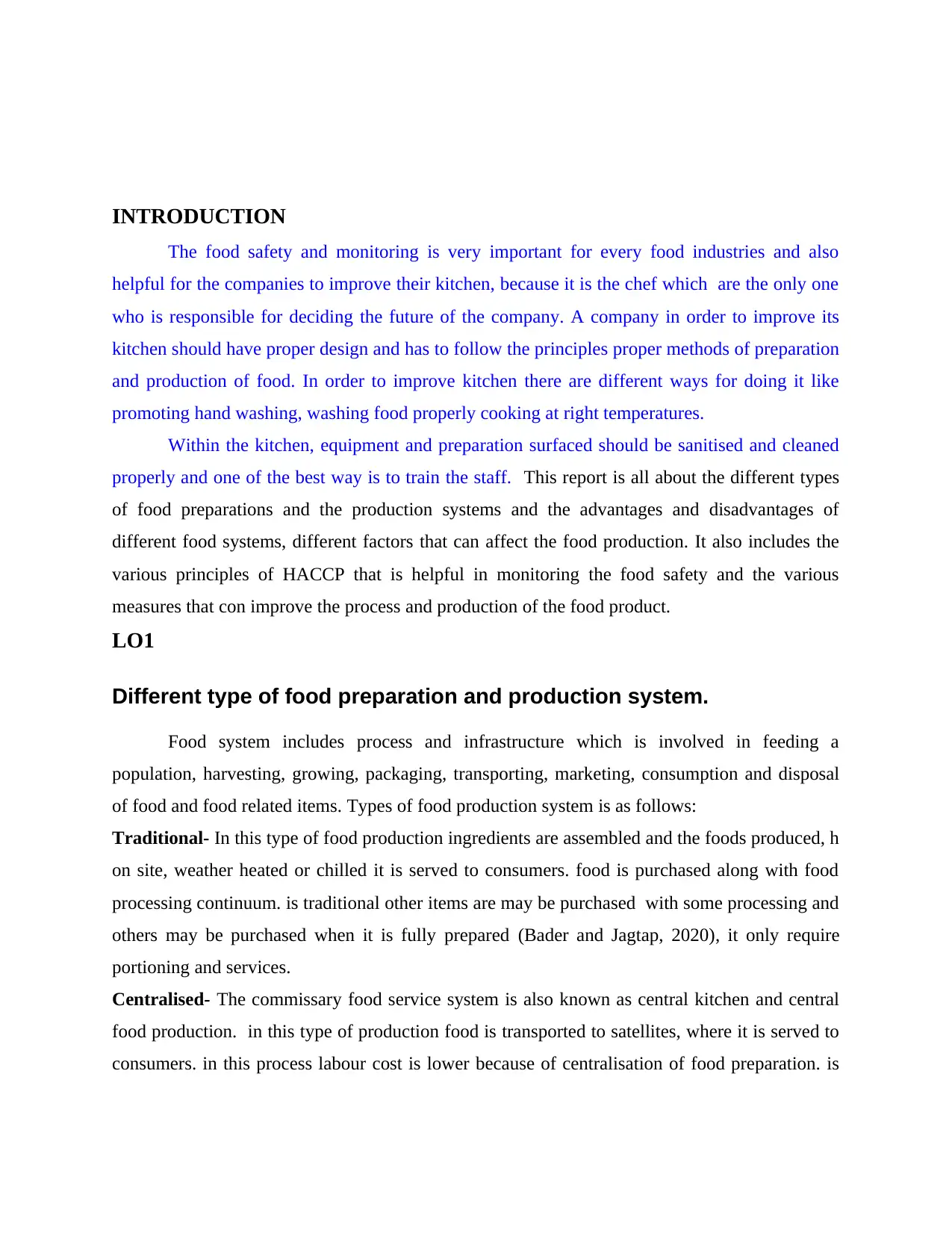
INTRODUCTION
The food safety and monitoring is very important for every food industries and also
helpful for the companies to improve their kitchen, because it is the chef which are the only one
who is responsible for deciding the future of the company. A company in order to improve its
kitchen should have proper design and has to follow the principles proper methods of preparation
and production of food. In order to improve kitchen there are different ways for doing it like
promoting hand washing, washing food properly cooking at right temperatures.
Within the kitchen, equipment and preparation surfaced should be sanitised and cleaned
properly and one of the best way is to train the staff. This report is all about the different types
of food preparations and the production systems and the advantages and disadvantages of
different food systems, different factors that can affect the food production. It also includes the
various principles of HACCP that is helpful in monitoring the food safety and the various
measures that con improve the process and production of the food product.
LO1
Different type of food preparation and production system.
Food system includes process and infrastructure which is involved in feeding a
population, harvesting, growing, packaging, transporting, marketing, consumption and disposal
of food and food related items. Types of food production system is as follows:
Traditional- In this type of food production ingredients are assembled and the foods produced, h
on site, weather heated or chilled it is served to consumers. food is purchased along with food
processing continuum. is traditional other items are may be purchased with some processing and
others may be purchased when it is fully prepared (Bader and Jagtap, 2020), it only require
portioning and services.
Centralised- The commissary food service system is also known as central kitchen and central
food production. in this type of production food is transported to satellites, where it is served to
consumers. in this process labour cost is lower because of centralisation of food preparation. is
The food safety and monitoring is very important for every food industries and also
helpful for the companies to improve their kitchen, because it is the chef which are the only one
who is responsible for deciding the future of the company. A company in order to improve its
kitchen should have proper design and has to follow the principles proper methods of preparation
and production of food. In order to improve kitchen there are different ways for doing it like
promoting hand washing, washing food properly cooking at right temperatures.
Within the kitchen, equipment and preparation surfaced should be sanitised and cleaned
properly and one of the best way is to train the staff. This report is all about the different types
of food preparations and the production systems and the advantages and disadvantages of
different food systems, different factors that can affect the food production. It also includes the
various principles of HACCP that is helpful in monitoring the food safety and the various
measures that con improve the process and production of the food product.
LO1
Different type of food preparation and production system.
Food system includes process and infrastructure which is involved in feeding a
population, harvesting, growing, packaging, transporting, marketing, consumption and disposal
of food and food related items. Types of food production system is as follows:
Traditional- In this type of food production ingredients are assembled and the foods produced, h
on site, weather heated or chilled it is served to consumers. food is purchased along with food
processing continuum. is traditional other items are may be purchased with some processing and
others may be purchased when it is fully prepared (Bader and Jagtap, 2020), it only require
portioning and services.
Centralised- The commissary food service system is also known as central kitchen and central
food production. in this type of production food is transported to satellites, where it is served to
consumers. in this process labour cost is lower because of centralisation of food preparation. is
⊘ This is a preview!⊘
Do you want full access?
Subscribe today to unlock all pages.

Trusted by 1+ million students worldwide
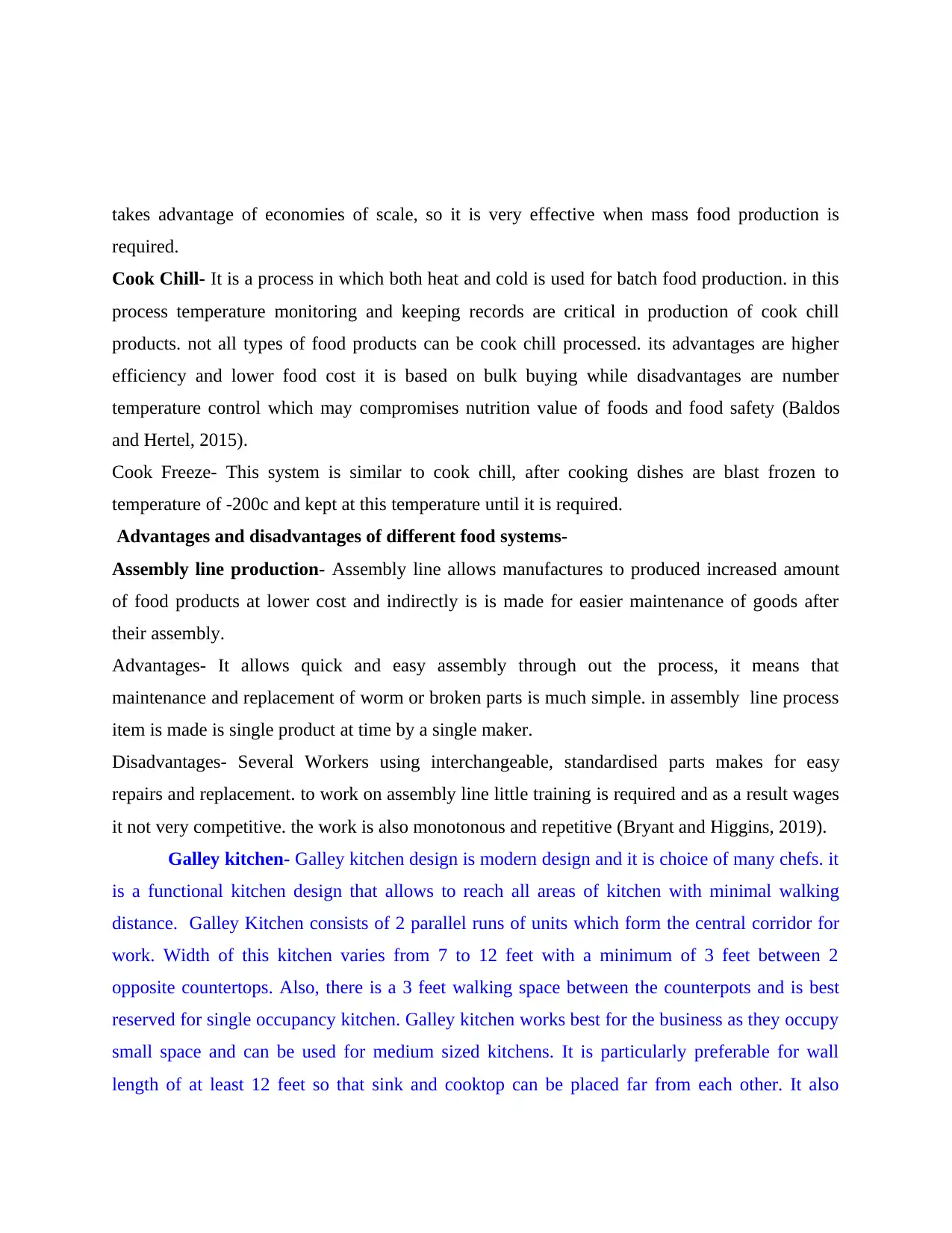
takes advantage of economies of scale, so it is very effective when mass food production is
required.
Cook Chill- It is a process in which both heat and cold is used for batch food production. in this
process temperature monitoring and keeping records are critical in production of cook chill
products. not all types of food products can be cook chill processed. its advantages are higher
efficiency and lower food cost it is based on bulk buying while disadvantages are number
temperature control which may compromises nutrition value of foods and food safety (Baldos
and Hertel, 2015).
Cook Freeze- This system is similar to cook chill, after cooking dishes are blast frozen to
temperature of -200c and kept at this temperature until it is required.
Advantages and disadvantages of different food systems-
Assembly line production- Assembly line allows manufactures to produced increased amount
of food products at lower cost and indirectly is is made for easier maintenance of goods after
their assembly.
Advantages- It allows quick and easy assembly through out the process, it means that
maintenance and replacement of worm or broken parts is much simple. in assembly line process
item is made is single product at time by a single maker.
Disadvantages- Several Workers using interchangeable, standardised parts makes for easy
repairs and replacement. to work on assembly line little training is required and as a result wages
it not very competitive. the work is also monotonous and repetitive (Bryant and Higgins, 2019).
Galley kitchen- Galley kitchen design is modern design and it is choice of many chefs. it
is a functional kitchen design that allows to reach all areas of kitchen with minimal walking
distance. Galley Kitchen consists of 2 parallel runs of units which form the central corridor for
work. Width of this kitchen varies from 7 to 12 feet with a minimum of 3 feet between 2
opposite countertops. Also, there is a 3 feet walking space between the counterpots and is best
reserved for single occupancy kitchen. Galley kitchen works best for the business as they occupy
small space and can be used for medium sized kitchens. It is particularly preferable for wall
length of at least 12 feet so that sink and cooktop can be placed far from each other. It also
required.
Cook Chill- It is a process in which both heat and cold is used for batch food production. in this
process temperature monitoring and keeping records are critical in production of cook chill
products. not all types of food products can be cook chill processed. its advantages are higher
efficiency and lower food cost it is based on bulk buying while disadvantages are number
temperature control which may compromises nutrition value of foods and food safety (Baldos
and Hertel, 2015).
Cook Freeze- This system is similar to cook chill, after cooking dishes are blast frozen to
temperature of -200c and kept at this temperature until it is required.
Advantages and disadvantages of different food systems-
Assembly line production- Assembly line allows manufactures to produced increased amount
of food products at lower cost and indirectly is is made for easier maintenance of goods after
their assembly.
Advantages- It allows quick and easy assembly through out the process, it means that
maintenance and replacement of worm or broken parts is much simple. in assembly line process
item is made is single product at time by a single maker.
Disadvantages- Several Workers using interchangeable, standardised parts makes for easy
repairs and replacement. to work on assembly line little training is required and as a result wages
it not very competitive. the work is also monotonous and repetitive (Bryant and Higgins, 2019).
Galley kitchen- Galley kitchen design is modern design and it is choice of many chefs. it
is a functional kitchen design that allows to reach all areas of kitchen with minimal walking
distance. Galley Kitchen consists of 2 parallel runs of units which form the central corridor for
work. Width of this kitchen varies from 7 to 12 feet with a minimum of 3 feet between 2
opposite countertops. Also, there is a 3 feet walking space between the counterpots and is best
reserved for single occupancy kitchen. Galley kitchen works best for the business as they occupy
small space and can be used for medium sized kitchens. It is particularly preferable for wall
length of at least 12 feet so that sink and cooktop can be placed far from each other. It also
Paraphrase This Document
Need a fresh take? Get an instant paraphrase of this document with our AI Paraphraser
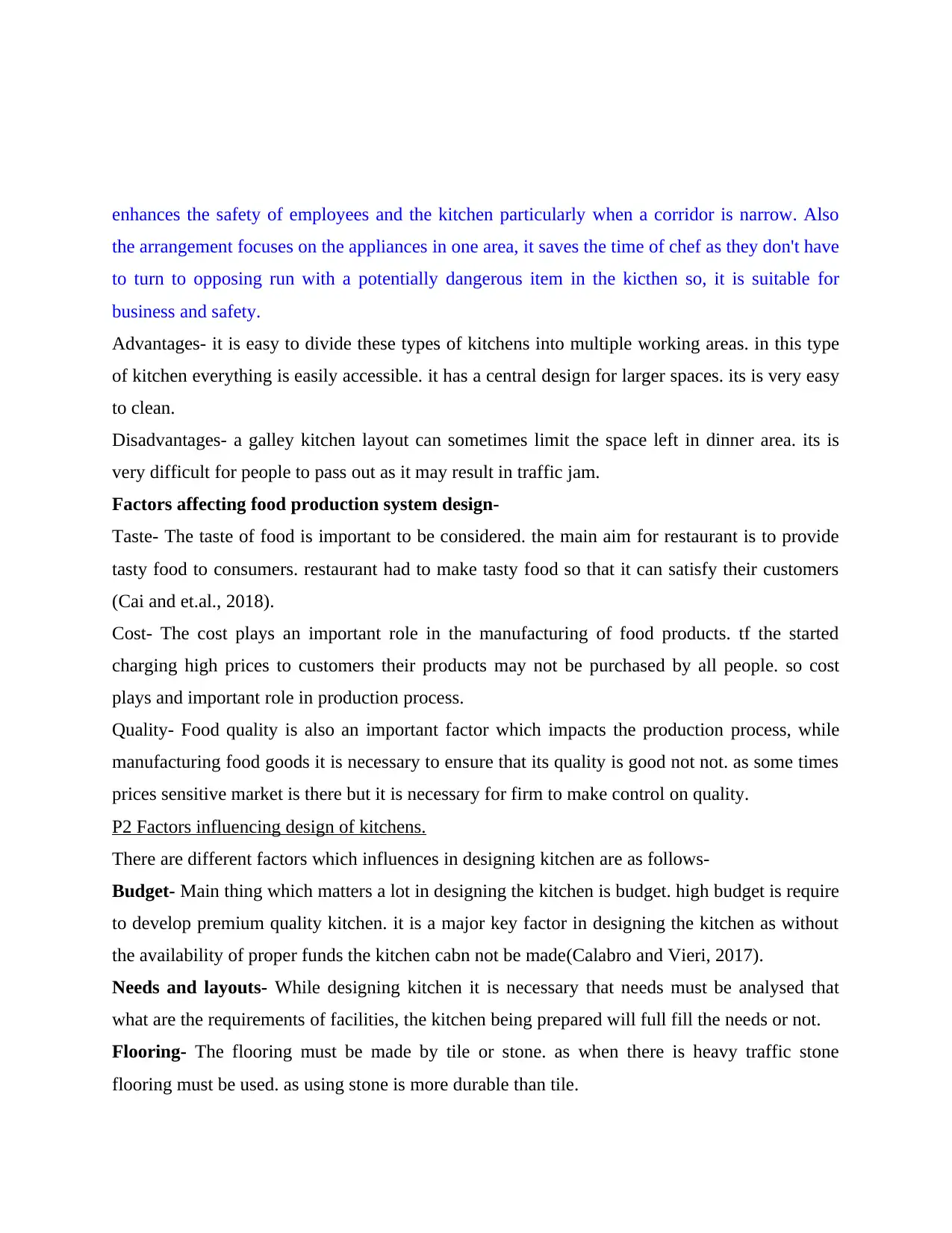
enhances the safety of employees and the kitchen particularly when a corridor is narrow. Also
the arrangement focuses on the appliances in one area, it saves the time of chef as they don't have
to turn to opposing run with a potentially dangerous item in the kicthen so, it is suitable for
business and safety.
Advantages- it is easy to divide these types of kitchens into multiple working areas. in this type
of kitchen everything is easily accessible. it has a central design for larger spaces. its is very easy
to clean.
Disadvantages- a galley kitchen layout can sometimes limit the space left in dinner area. its is
very difficult for people to pass out as it may result in traffic jam.
Factors affecting food production system design-
Taste- The taste of food is important to be considered. the main aim for restaurant is to provide
tasty food to consumers. restaurant had to make tasty food so that it can satisfy their customers
(Cai and et.al., 2018).
Cost- The cost plays an important role in the manufacturing of food products. tf the started
charging high prices to customers their products may not be purchased by all people. so cost
plays and important role in production process.
Quality- Food quality is also an important factor which impacts the production process, while
manufacturing food goods it is necessary to ensure that its quality is good not not. as some times
prices sensitive market is there but it is necessary for firm to make control on quality.
P2 Factors influencing design of kitchens.
There are different factors which influences in designing kitchen are as follows-
Budget- Main thing which matters a lot in designing the kitchen is budget. high budget is require
to develop premium quality kitchen. it is a major key factor in designing the kitchen as without
the availability of proper funds the kitchen cabn not be made(Calabro and Vieri, 2017).
Needs and layouts- While designing kitchen it is necessary that needs must be analysed that
what are the requirements of facilities, the kitchen being prepared will full fill the needs or not.
Flooring- The flooring must be made by tile or stone. as when there is heavy traffic stone
flooring must be used. as using stone is more durable than tile.
the arrangement focuses on the appliances in one area, it saves the time of chef as they don't have
to turn to opposing run with a potentially dangerous item in the kicthen so, it is suitable for
business and safety.
Advantages- it is easy to divide these types of kitchens into multiple working areas. in this type
of kitchen everything is easily accessible. it has a central design for larger spaces. its is very easy
to clean.
Disadvantages- a galley kitchen layout can sometimes limit the space left in dinner area. its is
very difficult for people to pass out as it may result in traffic jam.
Factors affecting food production system design-
Taste- The taste of food is important to be considered. the main aim for restaurant is to provide
tasty food to consumers. restaurant had to make tasty food so that it can satisfy their customers
(Cai and et.al., 2018).
Cost- The cost plays an important role in the manufacturing of food products. tf the started
charging high prices to customers their products may not be purchased by all people. so cost
plays and important role in production process.
Quality- Food quality is also an important factor which impacts the production process, while
manufacturing food goods it is necessary to ensure that its quality is good not not. as some times
prices sensitive market is there but it is necessary for firm to make control on quality.
P2 Factors influencing design of kitchens.
There are different factors which influences in designing kitchen are as follows-
Budget- Main thing which matters a lot in designing the kitchen is budget. high budget is require
to develop premium quality kitchen. it is a major key factor in designing the kitchen as without
the availability of proper funds the kitchen cabn not be made(Calabro and Vieri, 2017).
Needs and layouts- While designing kitchen it is necessary that needs must be analysed that
what are the requirements of facilities, the kitchen being prepared will full fill the needs or not.
Flooring- The flooring must be made by tile or stone. as when there is heavy traffic stone
flooring must be used. as using stone is more durable than tile.
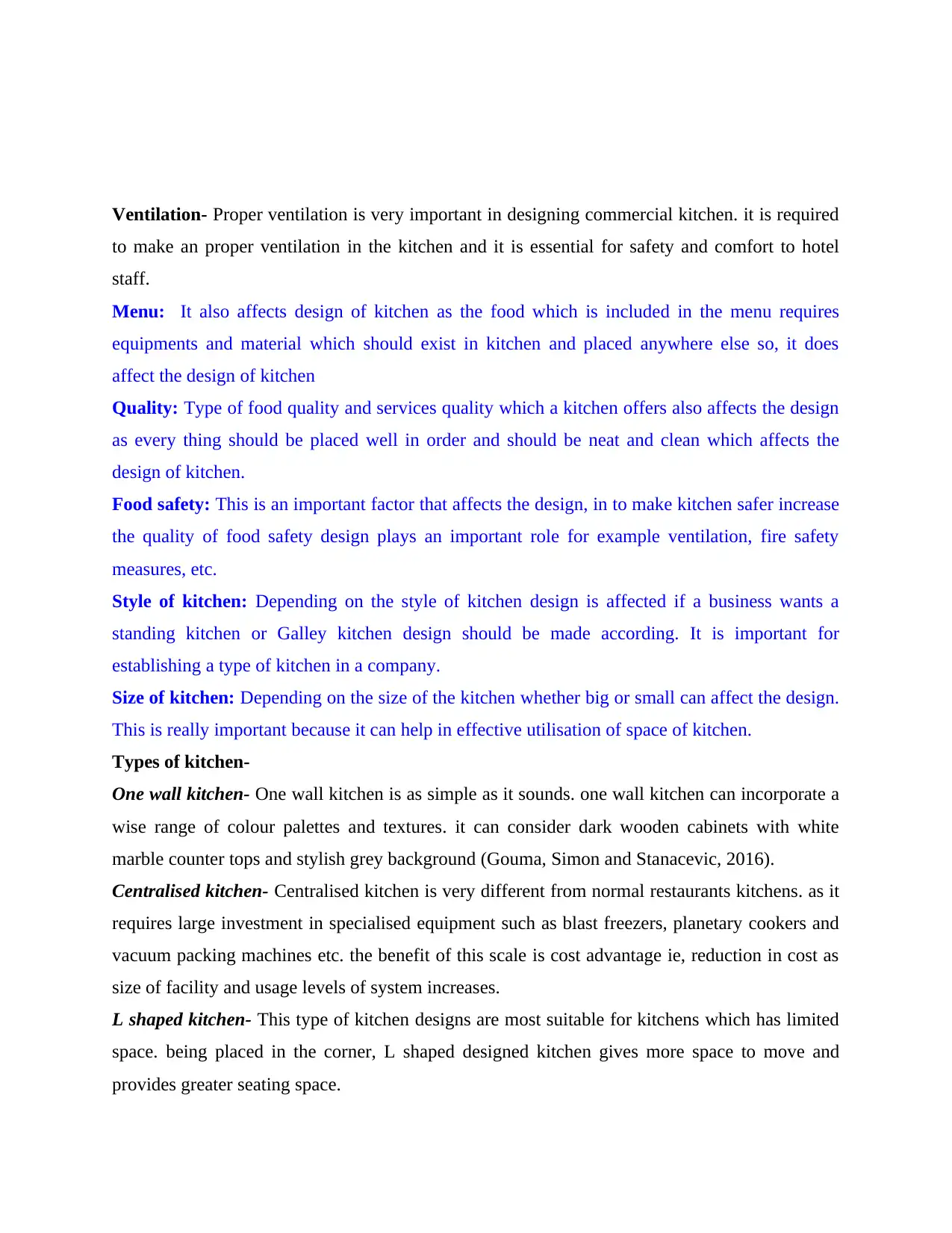
Ventilation- Proper ventilation is very important in designing commercial kitchen. it is required
to make an proper ventilation in the kitchen and it is essential for safety and comfort to hotel
staff.
Menu: It also affects design of kitchen as the food which is included in the menu requires
equipments and material which should exist in kitchen and placed anywhere else so, it does
affect the design of kitchen
Quality: Type of food quality and services quality which a kitchen offers also affects the design
as every thing should be placed well in order and should be neat and clean which affects the
design of kitchen.
Food safety: This is an important factor that affects the design, in to make kitchen safer increase
the quality of food safety design plays an important role for example ventilation, fire safety
measures, etc.
Style of kitchen: Depending on the style of kitchen design is affected if a business wants a
standing kitchen or Galley kitchen design should be made according. It is important for
establishing a type of kitchen in a company.
Size of kitchen: Depending on the size of the kitchen whether big or small can affect the design.
This is really important because it can help in effective utilisation of space of kitchen.
Types of kitchen-
One wall kitchen- One wall kitchen is as simple as it sounds. one wall kitchen can incorporate a
wise range of colour palettes and textures. it can consider dark wooden cabinets with white
marble counter tops and stylish grey background (Gouma, Simon and Stanacevic, 2016).
Centralised kitchen- Centralised kitchen is very different from normal restaurants kitchens. as it
requires large investment in specialised equipment such as blast freezers, planetary cookers and
vacuum packing machines etc. the benefit of this scale is cost advantage ie, reduction in cost as
size of facility and usage levels of system increases.
L shaped kitchen- This type of kitchen designs are most suitable for kitchens which has limited
space. being placed in the corner, L shaped designed kitchen gives more space to move and
provides greater seating space.
to make an proper ventilation in the kitchen and it is essential for safety and comfort to hotel
staff.
Menu: It also affects design of kitchen as the food which is included in the menu requires
equipments and material which should exist in kitchen and placed anywhere else so, it does
affect the design of kitchen
Quality: Type of food quality and services quality which a kitchen offers also affects the design
as every thing should be placed well in order and should be neat and clean which affects the
design of kitchen.
Food safety: This is an important factor that affects the design, in to make kitchen safer increase
the quality of food safety design plays an important role for example ventilation, fire safety
measures, etc.
Style of kitchen: Depending on the style of kitchen design is affected if a business wants a
standing kitchen or Galley kitchen design should be made according. It is important for
establishing a type of kitchen in a company.
Size of kitchen: Depending on the size of the kitchen whether big or small can affect the design.
This is really important because it can help in effective utilisation of space of kitchen.
Types of kitchen-
One wall kitchen- One wall kitchen is as simple as it sounds. one wall kitchen can incorporate a
wise range of colour palettes and textures. it can consider dark wooden cabinets with white
marble counter tops and stylish grey background (Gouma, Simon and Stanacevic, 2016).
Centralised kitchen- Centralised kitchen is very different from normal restaurants kitchens. as it
requires large investment in specialised equipment such as blast freezers, planetary cookers and
vacuum packing machines etc. the benefit of this scale is cost advantage ie, reduction in cost as
size of facility and usage levels of system increases.
L shaped kitchen- This type of kitchen designs are most suitable for kitchens which has limited
space. being placed in the corner, L shaped designed kitchen gives more space to move and
provides greater seating space.
⊘ This is a preview!⊘
Do you want full access?
Subscribe today to unlock all pages.

Trusted by 1+ million students worldwide
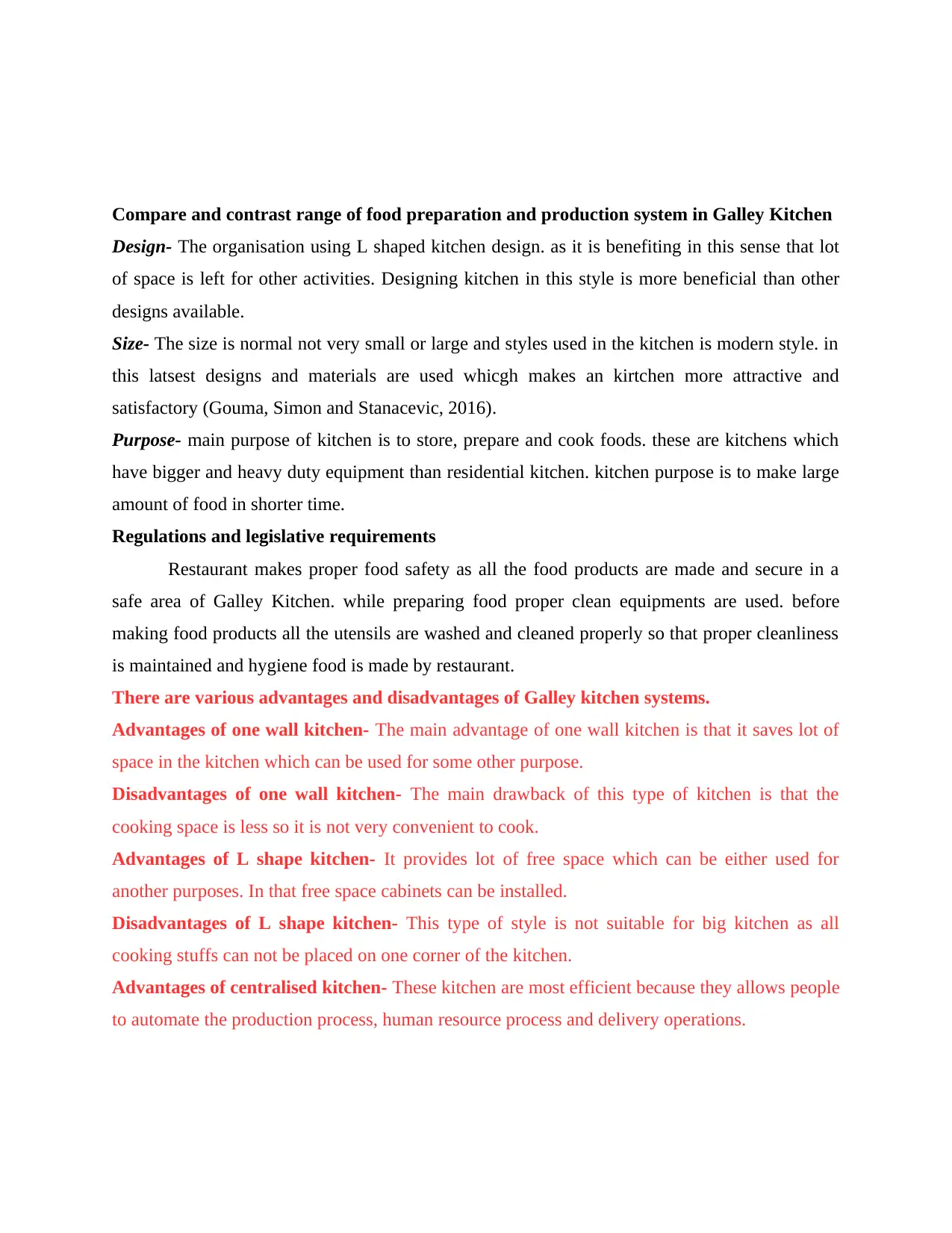
Compare and contrast range of food preparation and production system in Galley Kitchen
Design- The organisation using L shaped kitchen design. as it is benefiting in this sense that lot
of space is left for other activities. Designing kitchen in this style is more beneficial than other
designs available.
Size- The size is normal not very small or large and styles used in the kitchen is modern style. in
this latsest designs and materials are used whicgh makes an kirtchen more attractive and
satisfactory (Gouma, Simon and Stanacevic, 2016).
Purpose- main purpose of kitchen is to store, prepare and cook foods. these are kitchens which
have bigger and heavy duty equipment than residential kitchen. kitchen purpose is to make large
amount of food in shorter time.
Regulations and legislative requirements
Restaurant makes proper food safety as all the food products are made and secure in a
safe area of Galley Kitchen. while preparing food proper clean equipments are used. before
making food products all the utensils are washed and cleaned properly so that proper cleanliness
is maintained and hygiene food is made by restaurant.
There are various advantages and disadvantages of Galley kitchen systems.
Advantages of one wall kitchen- The main advantage of one wall kitchen is that it saves lot of
space in the kitchen which can be used for some other purpose.
Disadvantages of one wall kitchen- The main drawback of this type of kitchen is that the
cooking space is less so it is not very convenient to cook.
Advantages of L shape kitchen- It provides lot of free space which can be either used for
another purposes. In that free space cabinets can be installed.
Disadvantages of L shape kitchen- This type of style is not suitable for big kitchen as all
cooking stuffs can not be placed on one corner of the kitchen.
Advantages of centralised kitchen- These kitchen are most efficient because they allows people
to automate the production process, human resource process and delivery operations.
Design- The organisation using L shaped kitchen design. as it is benefiting in this sense that lot
of space is left for other activities. Designing kitchen in this style is more beneficial than other
designs available.
Size- The size is normal not very small or large and styles used in the kitchen is modern style. in
this latsest designs and materials are used whicgh makes an kirtchen more attractive and
satisfactory (Gouma, Simon and Stanacevic, 2016).
Purpose- main purpose of kitchen is to store, prepare and cook foods. these are kitchens which
have bigger and heavy duty equipment than residential kitchen. kitchen purpose is to make large
amount of food in shorter time.
Regulations and legislative requirements
Restaurant makes proper food safety as all the food products are made and secure in a
safe area of Galley Kitchen. while preparing food proper clean equipments are used. before
making food products all the utensils are washed and cleaned properly so that proper cleanliness
is maintained and hygiene food is made by restaurant.
There are various advantages and disadvantages of Galley kitchen systems.
Advantages of one wall kitchen- The main advantage of one wall kitchen is that it saves lot of
space in the kitchen which can be used for some other purpose.
Disadvantages of one wall kitchen- The main drawback of this type of kitchen is that the
cooking space is less so it is not very convenient to cook.
Advantages of L shape kitchen- It provides lot of free space which can be either used for
another purposes. In that free space cabinets can be installed.
Disadvantages of L shape kitchen- This type of style is not suitable for big kitchen as all
cooking stuffs can not be placed on one corner of the kitchen.
Advantages of centralised kitchen- These kitchen are most efficient because they allows people
to automate the production process, human resource process and delivery operations.
Paraphrase This Document
Need a fresh take? Get an instant paraphrase of this document with our AI Paraphraser
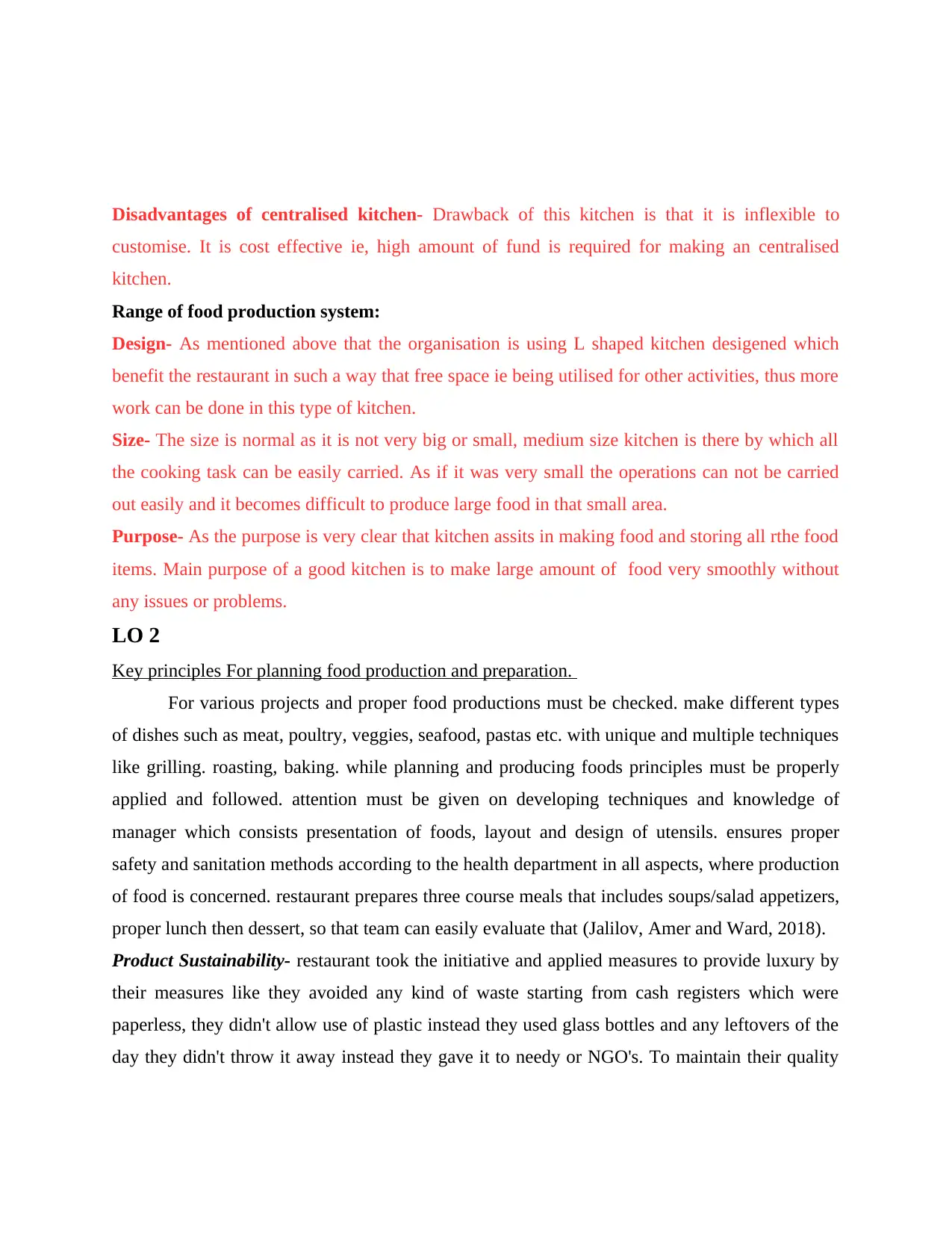
Disadvantages of centralised kitchen- Drawback of this kitchen is that it is inflexible to
customise. It is cost effective ie, high amount of fund is required for making an centralised
kitchen.
Range of food production system:
Design- As mentioned above that the organisation is using L shaped kitchen desigened which
benefit the restaurant in such a way that free space ie being utilised for other activities, thus more
work can be done in this type of kitchen.
Size- The size is normal as it is not very big or small, medium size kitchen is there by which all
the cooking task can be easily carried. As if it was very small the operations can not be carried
out easily and it becomes difficult to produce large food in that small area.
Purpose- As the purpose is very clear that kitchen assits in making food and storing all rthe food
items. Main purpose of a good kitchen is to make large amount of food very smoothly without
any issues or problems.
LO 2
Key principles For planning food production and preparation.
For various projects and proper food productions must be checked. make different types
of dishes such as meat, poultry, veggies, seafood, pastas etc. with unique and multiple techniques
like grilling. roasting, baking. while planning and producing foods principles must be properly
applied and followed. attention must be given on developing techniques and knowledge of
manager which consists presentation of foods, layout and design of utensils. ensures proper
safety and sanitation methods according to the health department in all aspects, where production
of food is concerned. restaurant prepares three course meals that includes soups/salad appetizers,
proper lunch then dessert, so that team can easily evaluate that (Jalilov, Amer and Ward, 2018).
Product Sustainability- restaurant took the initiative and applied measures to provide luxury by
their measures like they avoided any kind of waste starting from cash registers which were
paperless, they didn't allow use of plastic instead they used glass bottles and any leftovers of the
day they didn't throw it away instead they gave it to needy or NGO's. To maintain their quality
customise. It is cost effective ie, high amount of fund is required for making an centralised
kitchen.
Range of food production system:
Design- As mentioned above that the organisation is using L shaped kitchen desigened which
benefit the restaurant in such a way that free space ie being utilised for other activities, thus more
work can be done in this type of kitchen.
Size- The size is normal as it is not very big or small, medium size kitchen is there by which all
the cooking task can be easily carried. As if it was very small the operations can not be carried
out easily and it becomes difficult to produce large food in that small area.
Purpose- As the purpose is very clear that kitchen assits in making food and storing all rthe food
items. Main purpose of a good kitchen is to make large amount of food very smoothly without
any issues or problems.
LO 2
Key principles For planning food production and preparation.
For various projects and proper food productions must be checked. make different types
of dishes such as meat, poultry, veggies, seafood, pastas etc. with unique and multiple techniques
like grilling. roasting, baking. while planning and producing foods principles must be properly
applied and followed. attention must be given on developing techniques and knowledge of
manager which consists presentation of foods, layout and design of utensils. ensures proper
safety and sanitation methods according to the health department in all aspects, where production
of food is concerned. restaurant prepares three course meals that includes soups/salad appetizers,
proper lunch then dessert, so that team can easily evaluate that (Jalilov, Amer and Ward, 2018).
Product Sustainability- restaurant took the initiative and applied measures to provide luxury by
their measures like they avoided any kind of waste starting from cash registers which were
paperless, they didn't allow use of plastic instead they used glass bottles and any leftovers of the
day they didn't throw it away instead they gave it to needy or NGO's. To maintain their quality
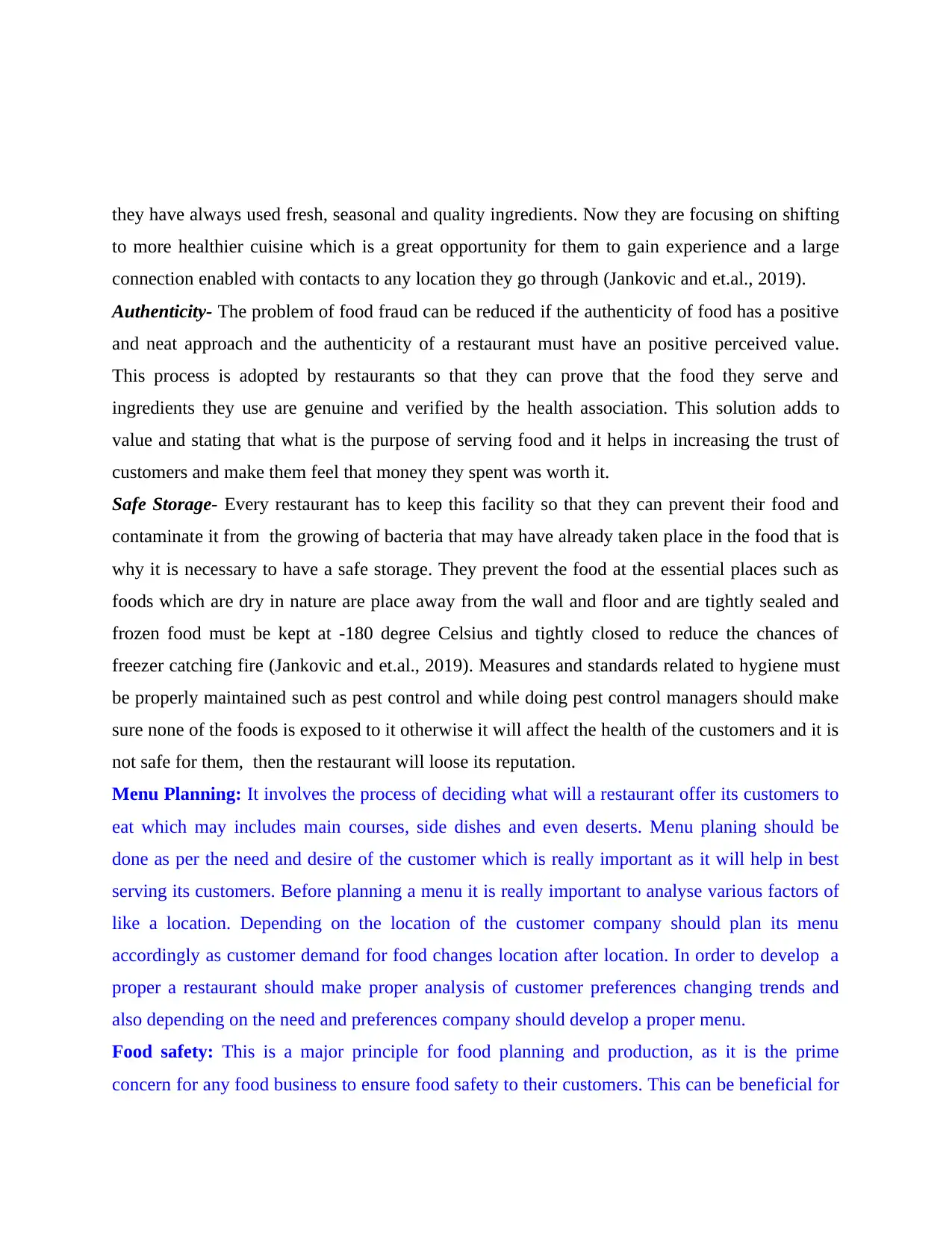
they have always used fresh, seasonal and quality ingredients. Now they are focusing on shifting
to more healthier cuisine which is a great opportunity for them to gain experience and a large
connection enabled with contacts to any location they go through (Jankovic and et.al., 2019).
Authenticity- The problem of food fraud can be reduced if the authenticity of food has a positive
and neat approach and the authenticity of a restaurant must have an positive perceived value.
This process is adopted by restaurants so that they can prove that the food they serve and
ingredients they use are genuine and verified by the health association. This solution adds to
value and stating that what is the purpose of serving food and it helps in increasing the trust of
customers and make them feel that money they spent was worth it.
Safe Storage- Every restaurant has to keep this facility so that they can prevent their food and
contaminate it from the growing of bacteria that may have already taken place in the food that is
why it is necessary to have a safe storage. They prevent the food at the essential places such as
foods which are dry in nature are place away from the wall and floor and are tightly sealed and
frozen food must be kept at -180 degree Celsius and tightly closed to reduce the chances of
freezer catching fire (Jankovic and et.al., 2019). Measures and standards related to hygiene must
be properly maintained such as pest control and while doing pest control managers should make
sure none of the foods is exposed to it otherwise it will affect the health of the customers and it is
not safe for them, then the restaurant will loose its reputation.
Menu Planning: It involves the process of deciding what will a restaurant offer its customers to
eat which may includes main courses, side dishes and even deserts. Menu planing should be
done as per the need and desire of the customer which is really important as it will help in best
serving its customers. Before planning a menu it is really important to analyse various factors of
like a location. Depending on the location of the customer company should plan its menu
accordingly as customer demand for food changes location after location. In order to develop a
proper a restaurant should make proper analysis of customer preferences changing trends and
also depending on the need and preferences company should develop a proper menu.
Food safety: This is a major principle for food planning and production, as it is the prime
concern for any food business to ensure food safety to their customers. This can be beneficial for
to more healthier cuisine which is a great opportunity for them to gain experience and a large
connection enabled with contacts to any location they go through (Jankovic and et.al., 2019).
Authenticity- The problem of food fraud can be reduced if the authenticity of food has a positive
and neat approach and the authenticity of a restaurant must have an positive perceived value.
This process is adopted by restaurants so that they can prove that the food they serve and
ingredients they use are genuine and verified by the health association. This solution adds to
value and stating that what is the purpose of serving food and it helps in increasing the trust of
customers and make them feel that money they spent was worth it.
Safe Storage- Every restaurant has to keep this facility so that they can prevent their food and
contaminate it from the growing of bacteria that may have already taken place in the food that is
why it is necessary to have a safe storage. They prevent the food at the essential places such as
foods which are dry in nature are place away from the wall and floor and are tightly sealed and
frozen food must be kept at -180 degree Celsius and tightly closed to reduce the chances of
freezer catching fire (Jankovic and et.al., 2019). Measures and standards related to hygiene must
be properly maintained such as pest control and while doing pest control managers should make
sure none of the foods is exposed to it otherwise it will affect the health of the customers and it is
not safe for them, then the restaurant will loose its reputation.
Menu Planning: It involves the process of deciding what will a restaurant offer its customers to
eat which may includes main courses, side dishes and even deserts. Menu planing should be
done as per the need and desire of the customer which is really important as it will help in best
serving its customers. Before planning a menu it is really important to analyse various factors of
like a location. Depending on the location of the customer company should plan its menu
accordingly as customer demand for food changes location after location. In order to develop a
proper a restaurant should make proper analysis of customer preferences changing trends and
also depending on the need and preferences company should develop a proper menu.
Food safety: This is a major principle for food planning and production, as it is the prime
concern for any food business to ensure food safety to their customers. This can be beneficial for
⊘ This is a preview!⊘
Do you want full access?
Subscribe today to unlock all pages.

Trusted by 1+ million students worldwide
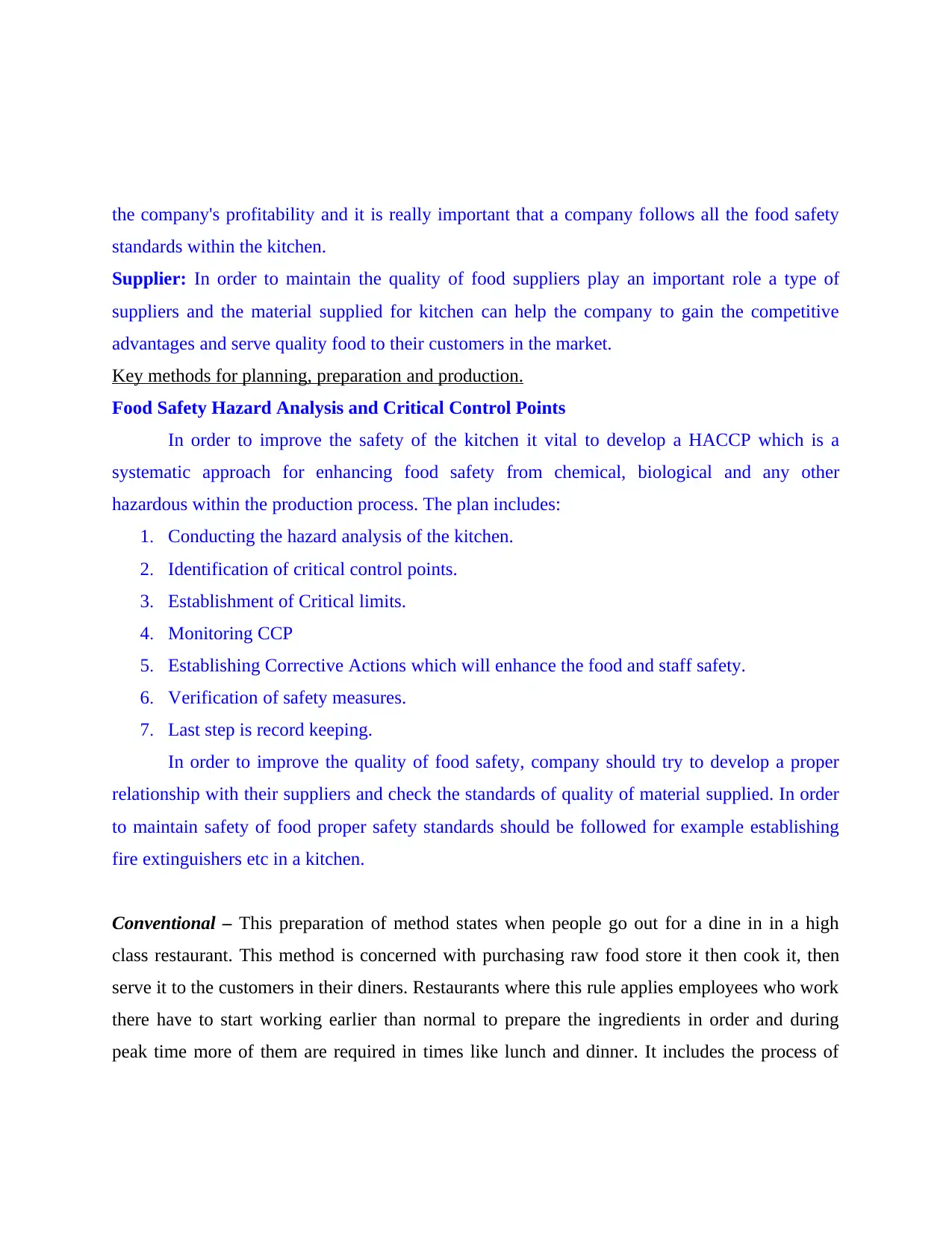
the company's profitability and it is really important that a company follows all the food safety
standards within the kitchen.
Supplier: In order to maintain the quality of food suppliers play an important role a type of
suppliers and the material supplied for kitchen can help the company to gain the competitive
advantages and serve quality food to their customers in the market.
Key methods for planning, preparation and production.
Food Safety Hazard Analysis and Critical Control Points
In order to improve the safety of the kitchen it vital to develop a HACCP which is a
systematic approach for enhancing food safety from chemical, biological and any other
hazardous within the production process. The plan includes:
1. Conducting the hazard analysis of the kitchen.
2. Identification of critical control points.
3. Establishment of Critical limits.
4. Monitoring CCP
5. Establishing Corrective Actions which will enhance the food and staff safety.
6. Verification of safety measures.
7. Last step is record keeping.
In order to improve the quality of food safety, company should try to develop a proper
relationship with their suppliers and check the standards of quality of material supplied. In order
to maintain safety of food proper safety standards should be followed for example establishing
fire extinguishers etc in a kitchen.
Conventional – This preparation of method states when people go out for a dine in in a high
class restaurant. This method is concerned with purchasing raw food store it then cook it, then
serve it to the customers in their diners. Restaurants where this rule applies employees who work
there have to start working earlier than normal to prepare the ingredients in order and during
peak time more of them are required in times like lunch and dinner. It includes the process of
standards within the kitchen.
Supplier: In order to maintain the quality of food suppliers play an important role a type of
suppliers and the material supplied for kitchen can help the company to gain the competitive
advantages and serve quality food to their customers in the market.
Key methods for planning, preparation and production.
Food Safety Hazard Analysis and Critical Control Points
In order to improve the safety of the kitchen it vital to develop a HACCP which is a
systematic approach for enhancing food safety from chemical, biological and any other
hazardous within the production process. The plan includes:
1. Conducting the hazard analysis of the kitchen.
2. Identification of critical control points.
3. Establishment of Critical limits.
4. Monitoring CCP
5. Establishing Corrective Actions which will enhance the food and staff safety.
6. Verification of safety measures.
7. Last step is record keeping.
In order to improve the quality of food safety, company should try to develop a proper
relationship with their suppliers and check the standards of quality of material supplied. In order
to maintain safety of food proper safety standards should be followed for example establishing
fire extinguishers etc in a kitchen.
Conventional – This preparation of method states when people go out for a dine in in a high
class restaurant. This method is concerned with purchasing raw food store it then cook it, then
serve it to the customers in their diners. Restaurants where this rule applies employees who work
there have to start working earlier than normal to prepare the ingredients in order and during
peak time more of them are required in times like lunch and dinner. It includes the process of
Paraphrase This Document
Need a fresh take? Get an instant paraphrase of this document with our AI Paraphraser
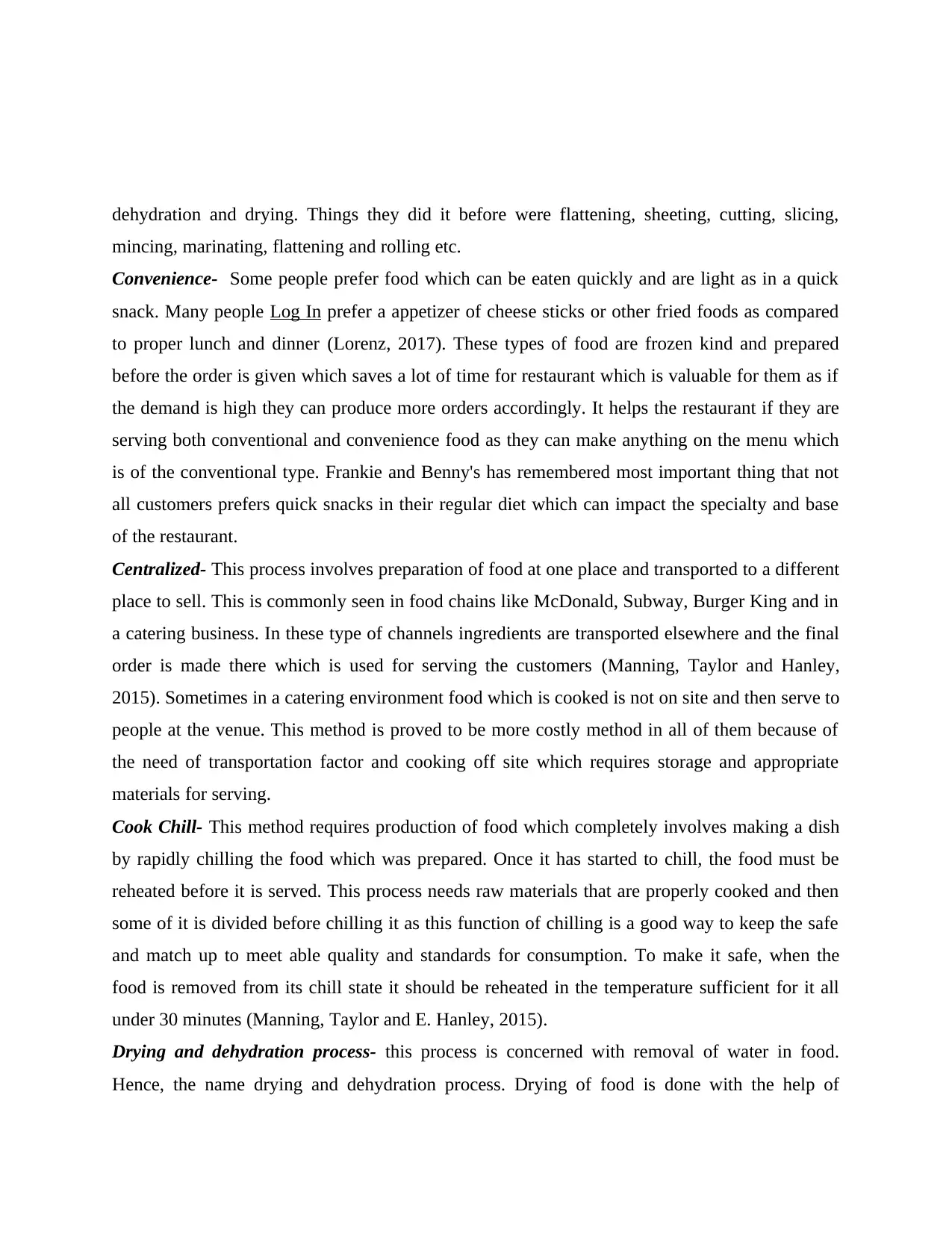
dehydration and drying. Things they did it before were flattening, sheeting, cutting, slicing,
mincing, marinating, flattening and rolling etc.
Convenience- Some people prefer food which can be eaten quickly and are light as in a quick
snack. Many people Log In prefer a appetizer of cheese sticks or other fried foods as compared
to proper lunch and dinner (Lorenz, 2017). These types of food are frozen kind and prepared
before the order is given which saves a lot of time for restaurant which is valuable for them as if
the demand is high they can produce more orders accordingly. It helps the restaurant if they are
serving both conventional and convenience food as they can make anything on the menu which
is of the conventional type. Frankie and Benny's has remembered most important thing that not
all customers prefers quick snacks in their regular diet which can impact the specialty and base
of the restaurant.
Centralized- This process involves preparation of food at one place and transported to a different
place to sell. This is commonly seen in food chains like McDonald, Subway, Burger King and in
a catering business. In these type of channels ingredients are transported elsewhere and the final
order is made there which is used for serving the customers (Manning, Taylor and Hanley,
2015). Sometimes in a catering environment food which is cooked is not on site and then serve to
people at the venue. This method is proved to be more costly method in all of them because of
the need of transportation factor and cooking off site which requires storage and appropriate
materials for serving.
Cook Chill- This method requires production of food which completely involves making a dish
by rapidly chilling the food which was prepared. Once it has started to chill, the food must be
reheated before it is served. This process needs raw materials that are properly cooked and then
some of it is divided before chilling it as this function of chilling is a good way to keep the safe
and match up to meet able quality and standards for consumption. To make it safe, when the
food is removed from its chill state it should be reheated in the temperature sufficient for it all
under 30 minutes (Manning, Taylor and E. Hanley, 2015).
Drying and dehydration process- this process is concerned with removal of water in food.
Hence, the name drying and dehydration process. Drying of food is done with the help of
mincing, marinating, flattening and rolling etc.
Convenience- Some people prefer food which can be eaten quickly and are light as in a quick
snack. Many people Log In prefer a appetizer of cheese sticks or other fried foods as compared
to proper lunch and dinner (Lorenz, 2017). These types of food are frozen kind and prepared
before the order is given which saves a lot of time for restaurant which is valuable for them as if
the demand is high they can produce more orders accordingly. It helps the restaurant if they are
serving both conventional and convenience food as they can make anything on the menu which
is of the conventional type. Frankie and Benny's has remembered most important thing that not
all customers prefers quick snacks in their regular diet which can impact the specialty and base
of the restaurant.
Centralized- This process involves preparation of food at one place and transported to a different
place to sell. This is commonly seen in food chains like McDonald, Subway, Burger King and in
a catering business. In these type of channels ingredients are transported elsewhere and the final
order is made there which is used for serving the customers (Manning, Taylor and Hanley,
2015). Sometimes in a catering environment food which is cooked is not on site and then serve to
people at the venue. This method is proved to be more costly method in all of them because of
the need of transportation factor and cooking off site which requires storage and appropriate
materials for serving.
Cook Chill- This method requires production of food which completely involves making a dish
by rapidly chilling the food which was prepared. Once it has started to chill, the food must be
reheated before it is served. This process needs raw materials that are properly cooked and then
some of it is divided before chilling it as this function of chilling is a good way to keep the safe
and match up to meet able quality and standards for consumption. To make it safe, when the
food is removed from its chill state it should be reheated in the temperature sufficient for it all
under 30 minutes (Manning, Taylor and E. Hanley, 2015).
Drying and dehydration process- this process is concerned with removal of water in food.
Hence, the name drying and dehydration process. Drying of food is done with the help of
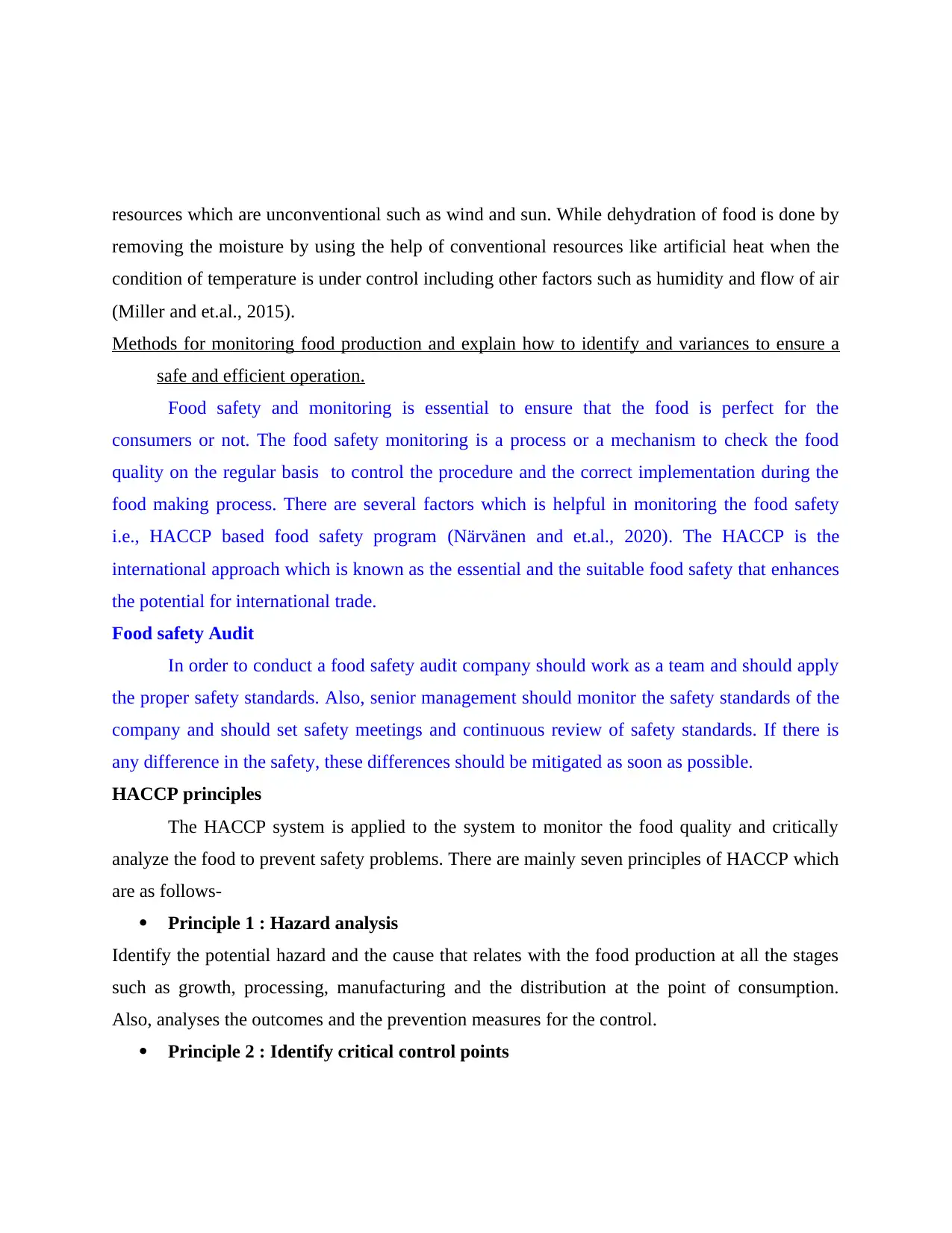
resources which are unconventional such as wind and sun. While dehydration of food is done by
removing the moisture by using the help of conventional resources like artificial heat when the
condition of temperature is under control including other factors such as humidity and flow of air
(Miller and et.al., 2015).
Methods for monitoring food production and explain how to identify and variances to ensure a
safe and efficient operation.
Food safety and monitoring is essential to ensure that the food is perfect for the
consumers or not. The food safety monitoring is a process or a mechanism to check the food
quality on the regular basis to control the procedure and the correct implementation during the
food making process. There are several factors which is helpful in monitoring the food safety
i.e., HACCP based food safety program (Närvänen and et.al., 2020). The HACCP is the
international approach which is known as the essential and the suitable food safety that enhances
the potential for international trade.
Food safety Audit
In order to conduct a food safety audit company should work as a team and should apply
the proper safety standards. Also, senior management should monitor the safety standards of the
company and should set safety meetings and continuous review of safety standards. If there is
any difference in the safety, these differences should be mitigated as soon as possible.
HACCP principles
The HACCP system is applied to the system to monitor the food quality and critically
analyze the food to prevent safety problems. There are mainly seven principles of HACCP which
are as follows-
Principle 1 : Hazard analysis
Identify the potential hazard and the cause that relates with the food production at all the stages
such as growth, processing, manufacturing and the distribution at the point of consumption.
Also, analyses the outcomes and the prevention measures for the control.
Principle 2 : Identify critical control points
removing the moisture by using the help of conventional resources like artificial heat when the
condition of temperature is under control including other factors such as humidity and flow of air
(Miller and et.al., 2015).
Methods for monitoring food production and explain how to identify and variances to ensure a
safe and efficient operation.
Food safety and monitoring is essential to ensure that the food is perfect for the
consumers or not. The food safety monitoring is a process or a mechanism to check the food
quality on the regular basis to control the procedure and the correct implementation during the
food making process. There are several factors which is helpful in monitoring the food safety
i.e., HACCP based food safety program (Närvänen and et.al., 2020). The HACCP is the
international approach which is known as the essential and the suitable food safety that enhances
the potential for international trade.
Food safety Audit
In order to conduct a food safety audit company should work as a team and should apply
the proper safety standards. Also, senior management should monitor the safety standards of the
company and should set safety meetings and continuous review of safety standards. If there is
any difference in the safety, these differences should be mitigated as soon as possible.
HACCP principles
The HACCP system is applied to the system to monitor the food quality and critically
analyze the food to prevent safety problems. There are mainly seven principles of HACCP which
are as follows-
Principle 1 : Hazard analysis
Identify the potential hazard and the cause that relates with the food production at all the stages
such as growth, processing, manufacturing and the distribution at the point of consumption.
Also, analyses the outcomes and the prevention measures for the control.
Principle 2 : Identify critical control points
⊘ This is a preview!⊘
Do you want full access?
Subscribe today to unlock all pages.

Trusted by 1+ million students worldwide
1 out of 25
Related Documents
Your All-in-One AI-Powered Toolkit for Academic Success.
+13062052269
info@desklib.com
Available 24*7 on WhatsApp / Email
![[object Object]](/_next/static/media/star-bottom.7253800d.svg)
Unlock your academic potential
Copyright © 2020–2025 A2Z Services. All Rights Reserved. Developed and managed by ZUCOL.




